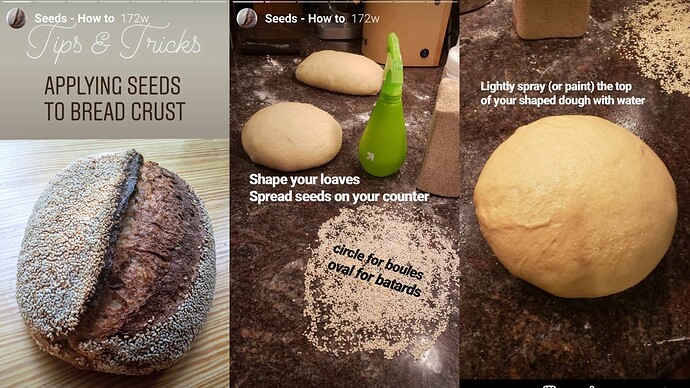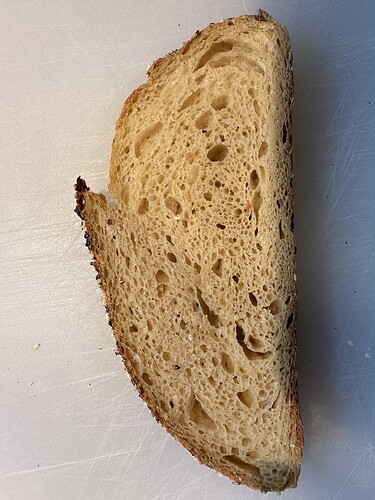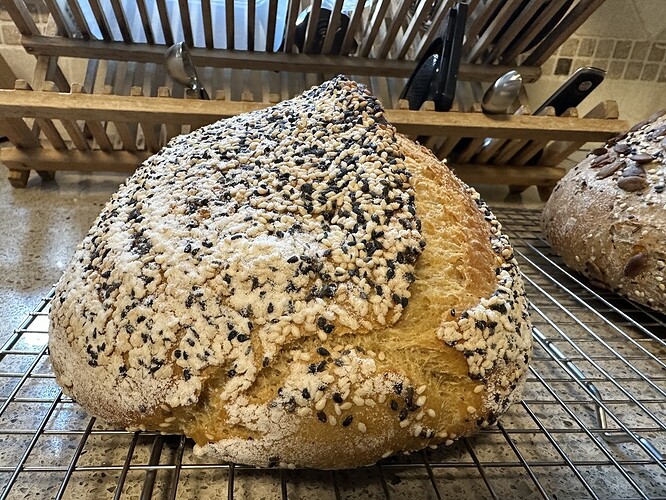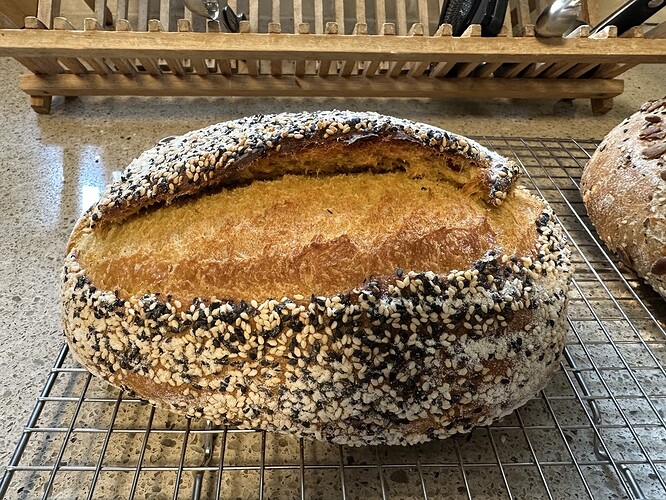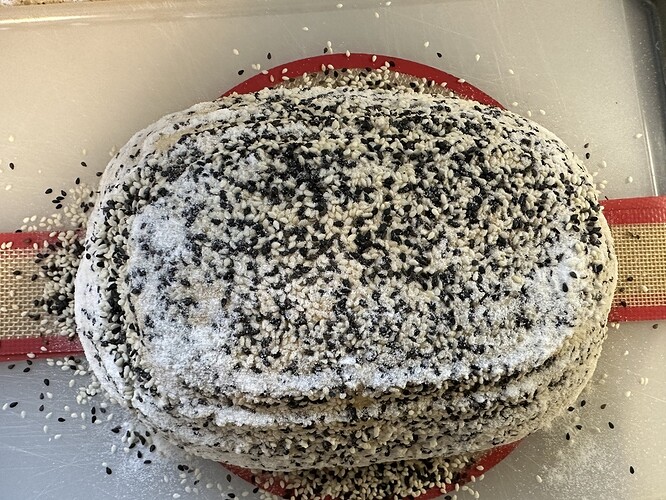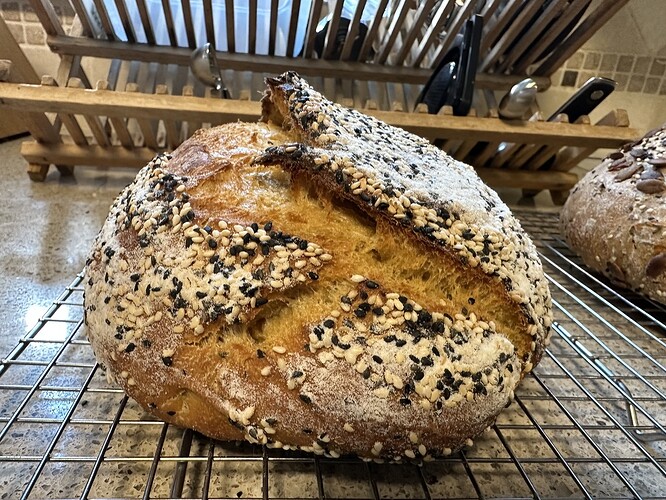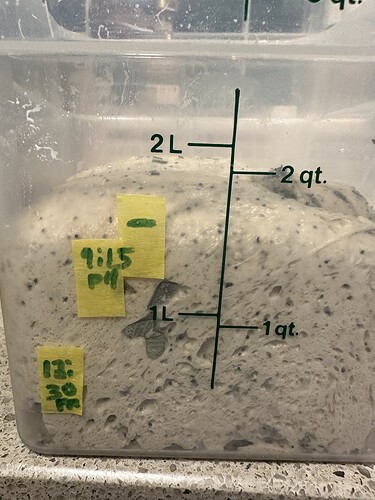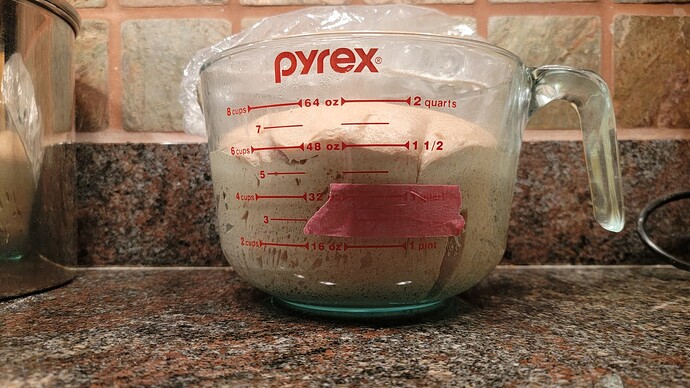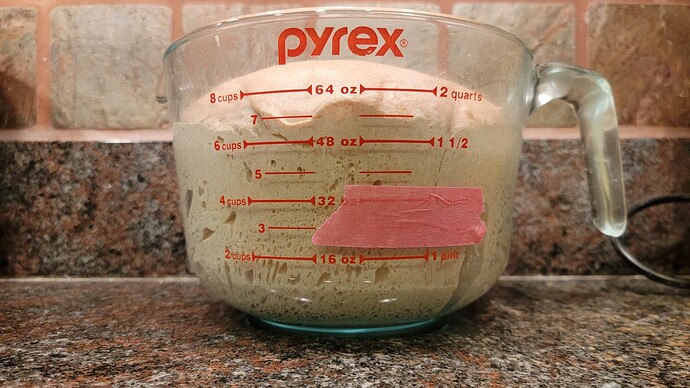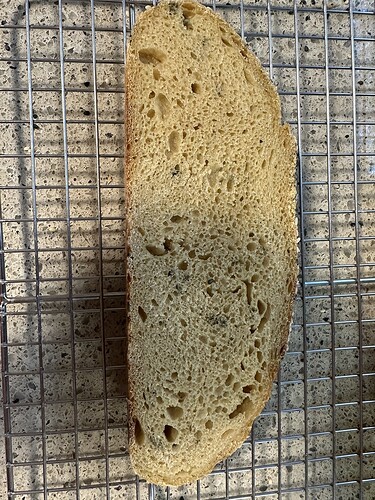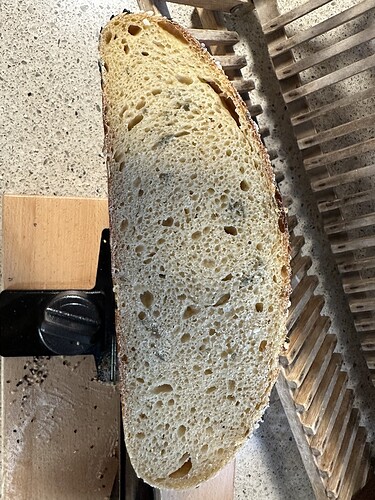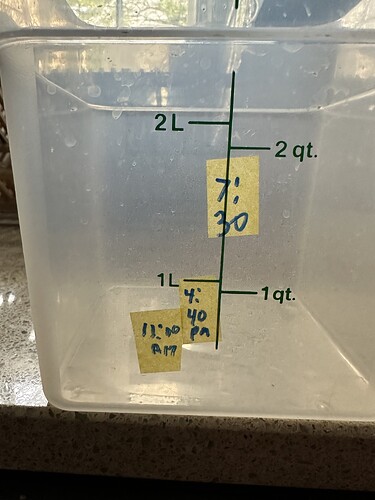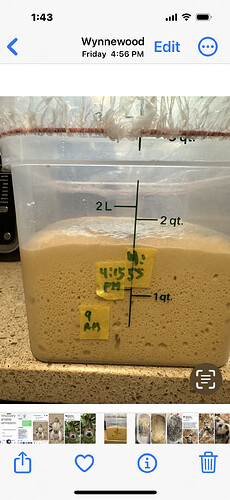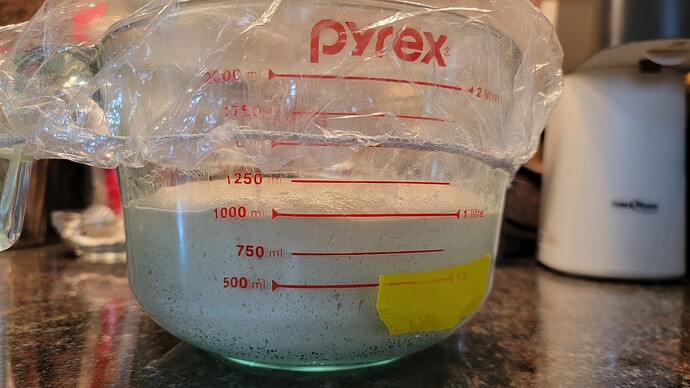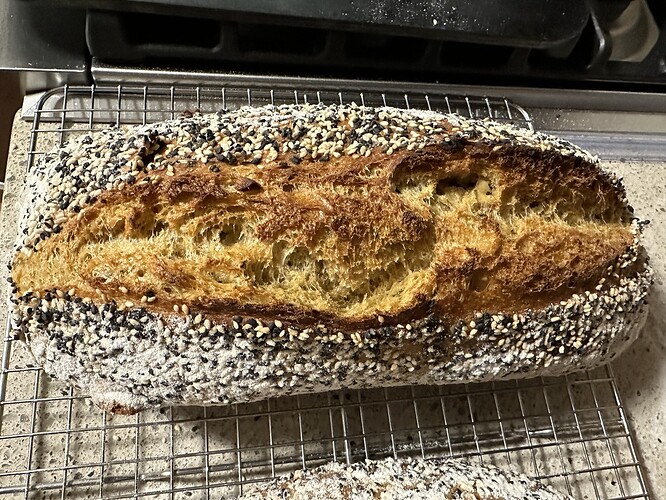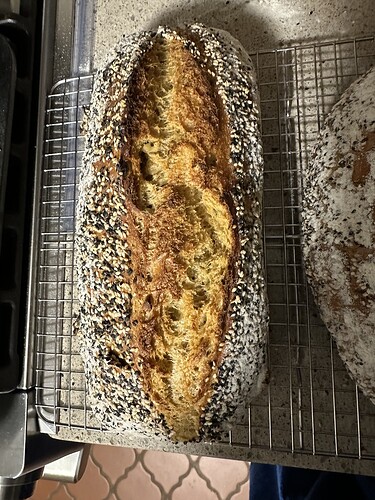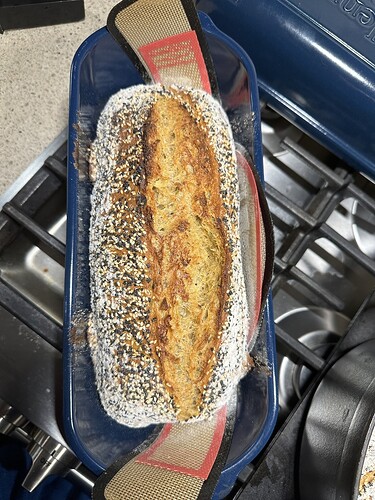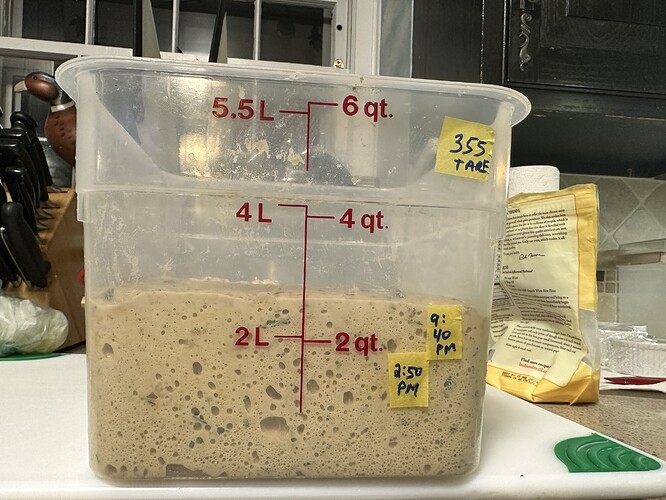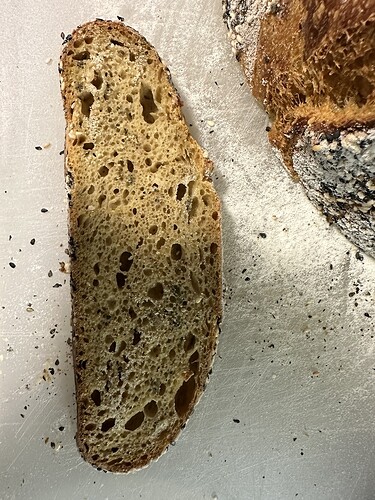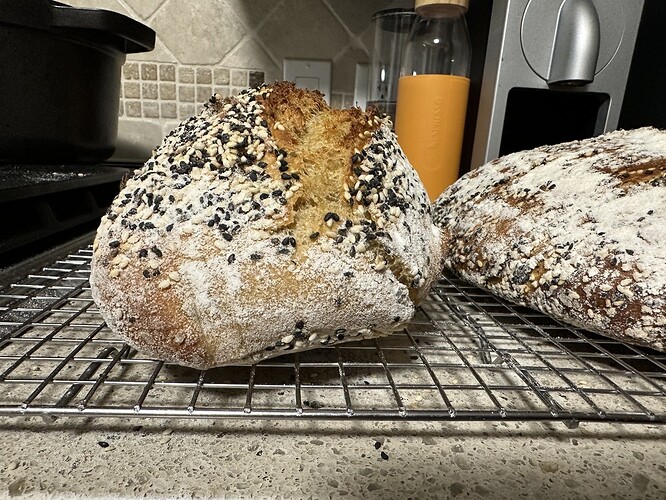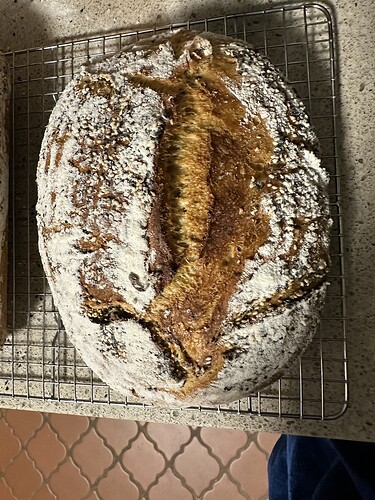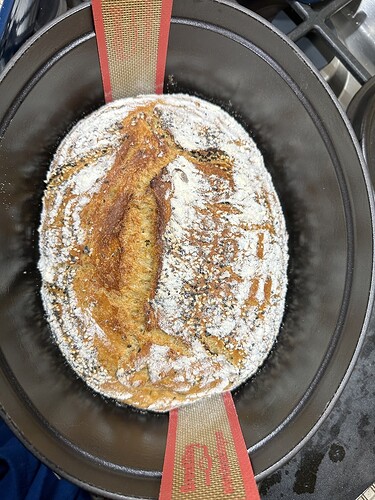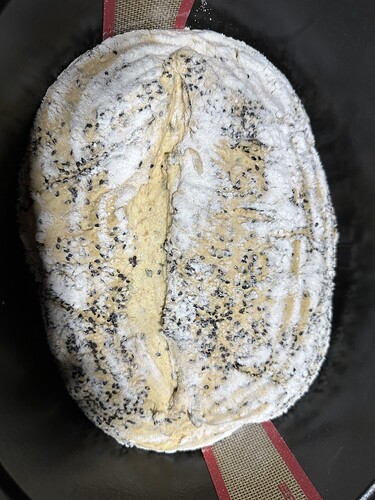How on earth do you drain sesame seeds?? Even my finest mesh strainer would lose quite a few!
You might try this seed application how-to. If you don’t have a water spray bottle, you can use a pastry brush.
Here is the original Instagram story.
I’m making the sourdough version for the first time. The yeast version was wonderful. I can control the dough temperature this time of year with a proofer. How much approximate rise and at what dough temperature would make sense to stop the bulk rise before shaping? Currently I’m proofing at 71F dough temperature but can speed it up with a higher temperature. Am I looking to stop bulk fermentation when the dough is giggly and doming or sooner since there’s a lot of non bread flour?
Also, I’m using sifted/bolted Durham, how would I generally adjust the recipe if I replaced the sifted Durham with fresh milled whole grain Durham? Thank you.
I’m guessing you already have your loaf of bread baked up. How did it turn out?
I think when I make this bread, I aim for 75%-100% rise on the bulk fermentation. The dough needs a little less water when you use bolted versus whole grain flour.
Thanks Melissa. First of all, the sourdough version of this recipe is excellent and easy to make. (Some more questions at bottom of this message! ) One of the tastiest and best looking breads I’ve made. And one I thought was going to overproof but to me came out near ideal. The Sourdough bread using bolted Durham was delicious and very soft. I scored and surprised at the ear. The dough was slacker than I expected though I had increased the hydration only slightly above the recipe amount. At 71F bulk ferment temp, it increased in 12 hours by double! It was too late too shape and bake, so I put it in the wine fridge at 52F overnight for 8 hrs. To my surprise, there was no further bulk growth even as it cooled down to wine fridge temp. I pre shaped, 30 min bench rest, final shaped, rolled in roasted black and white sesame seeds. 2 hrs at 68F/38%RH in the banneton, then scored and baked in a 450F preheated oval DO 35 min covered, then 9 min uncovered at 425F.
- I’m surprised I wasn’t over fermented. Does it make sense zero additional growth during the 8 hrs in the wine fridge? I was at least expecting some growth while it was cooling down.
0 does the bulk doubling in 12 hrs at 71F make sense? I was expecting it to take longer and actually would have probably stopped the bulk rise before it doubled.
- The % growth you give and the amount of bulk rise time in the original recipe doesn’t give a temperature. As I’m getting more experience, it seems that temperature is a key component as to when to stop bulk rise to avoid overfermenting. Can you provide some thoughts on the approx % rise relative to the dough temperature?
Your loaf looks great. I’m glad you got the surprise ear/oven spring.
Gas compresses at colder temperature, so the same size dough when cold is actually farther along. But I totally hear you on expecting some expansion especially at wine fridge temps! I’d chalk that up to the mysteries of sourdough.
Here’s a recent 11pm to 6:30am refrigerates expansion of bulk fermenting dough, maybe 78F to 38F temperature change.
Starter strength, starter %, flour type, and dough temp are all important variables in how fast or slow the dough will ferment.
If you can keep those first three variables constant, then the third fourth (dough temp control) will allow you to set a timer on your bulk fermentation – that is crucial in bakeries with massive production on a schedule.
Since you have a proofing box, you can start to track these things and have a lot of predictability.
Thanks Melissa,
I always have questions!
O after the room temperature bulk rise, if I shaped and put in the fridge 38F say for 6 to 16 hours, could I just bake this right away without letting it warm up, which is the way I bake a typical loaf?
O. This is considered a no knead recipe. In the notes Eric days after the initial mix to mix it again after 10 minutes I think due to the water absorption of the Durham. No stretch and folds in this recipe. Are recipes with stretch and folds considered no knead also? What would happen in this recipe if I gave it a few rounds of stretch and folds?
O. No knead recipes I understand don’t call for scoring. Eric did as he likes to score I think. I can understand that. If I didn’t score the way I did I know I wouldn’t get the well defined ear. Would I still get a lot of oven spring?
O. Here’s a big what if. If I didn’t have Durham available. What would happen if I used Caputo Semola Double milled flour durham wheat semolina?
Thanks again
Melissa, this recipe never ceases to amaze me in how easy it is to make and how forgiving it is. I bulk fermented this time much longer than I intended. At 73F dough temperature during entire bulk fermentation, I planned to stop at approx 60%, but instead stopped at slightly over double. I preshaped and shaped using Maurizio Leo’s technique for slack dough, then put banneton in freezer as I preheated oven to 460F. Forgot to preheat the DO, so frozen loaf after scoring went into room temp DO and into 460F oven.
Not much rise (no surprise), taste is wonderful.
What does the crumb tell you about the fermentation, etc? I was expecting significant over fermentation with the 73F dough temperature and amount of rise!
I converted the recipe to gms and increased it to a total of 500 gms flour. Here’s the baker’s percentages I came up with. Also added some fresh herbs.
88% hydration
Flour: 72% bolted Durham, 28% King Arthur Bread Flour
Barley Mill Syrup: 5%
Olive Oil: 3.4%
Starter: 14%
Salt: 2%
Fresh Herbs: 2%
Roasted black and white sesame seeds
Hi Philip,
I’m sorry I missed your questions from February. I’ll try to answer them and the ones from today ![]()
I rarely let dough warm up after I proof it in the refrigerator – only when I look at it and think it’s underproofed/nothing happened overnight.
Swapping a no knead approach versus doing many gluten development maneuvers and vice versa is the baker’s prerogative imo – it’s all about your time and goals calculus. If your process is warm and fast, I would say some active stretching and folding can have more of an impact on the bread outcome than if your process is cold/slow.
Edited to add: mostly rye or mostly einkorn doughs don’t benefit from active gluten development in my experience.
I only skip scoring if I bake the bread seam-side up. I think that is what Eric was doing in his no knead recipe. The seams burst and you still get oven spring that way – but if the seams from shaping are down and you don’t score, I do think the oven spring will be inhibited and/or you might get a funny side burst.
Edited to add: mostly rye or mostly einkorn doughs don’t warrant scoring. Also sandwich breads baked at lower temps.
Using semolina rimacinata will get you a slightly more open crumb because that flour doesn’t have the germ and bran of a durum whole grain flour.
Your 72% bolted durum loaf looks tasty and I think the fermentation is good. I often let my dough go that far. I do think the loaf would have been taller if the DO were preheated. My “favorite” mistake to make is to preheat everything at only 350F. Sigh.
You can check out my different crumbs in this pane altamura recipe. Two breads: one is 100% semolina rimacinata and the other is 60% durum whole grain paired with Breadtopia bread flour.
I made a variation on this bread recently. A mix of durum and Kamut for the whole grain component, and more like 50:50 with bread flour. Also honey instead of malted barley syrup. You can see I also took the bulk far.
Thanks Melissa for all the info. I need to try a durham/kamut blend. Were you using whole grain Durham and Kamut or did you screen it? How would I best approach deciding the hydration, % starter, % honey with the goal of trying to get a loaf with reasonable oven spring? I’ve been pleased with original Durham recipe using sourdough for oven spring as long as I don’t over ferment.
I have some Durham berries but haven’t milled them yet. Using a Komo which I understand is very similar to the Mockmill. Do you just grind them once on a very fine setting like I do with my other grains? I understand it’s the hardest grain and some say to grind Durham coarse first and then grind again fine. There was some implication that was to protect the mill but not clear to me the brand of the mill. Thanks.
I didn’t sift. Years ago I tried sifting finely milled durum and it all went through my #40. I think the bran shatters smaller in these golden wheats. I only tried once though so I’m not the expert voice on this.
I’ve heard that if you’re milling a lot of durum i.e. you’re running a bakery, you may want to freeze the durum berries to keep the system cool and so you can pass them through twice (warm flour doesn’t go through easily). For the amount of berries I mill at a time e.g. 250-1000g, I’ve never needed to freeze or double mill. I even once compared the output of RT one pass and frozen two passes – I couldn’t feel a difference in fineness.
I determine hydration by eye-feel-experience, since I was using less durum than Eric.
I went with 80% water, 6% honey (but no evoo) and I used only 6% starter (desem starter cold from the refrigerator). In my experience, when you’re using a weak gluten flour, you can get a little more height if the dough is a little dryer, and 80% with these flours was not particularly slack.
I did 1 or 2 S&Fs – no notes on that since this wasn’t for work :). I knew I’d get plenty of gluten development with the long bulk ferment (small amount of starter) further extended by the dough spending the night at around 55F in a cold vestibule.
The final proof was RT and short.
Hi Melissa, I’ve upscaled the recipe to 1000 gms total flour and plan to divide into two loaves during shaping. By mistake I forgot to double the starter quantity. So far, it has been bulk fermenting for 4.5 hrs at 74F in the proofer with no growth. For flour, I used 515 gms sifted Durham, 205gms fresh milled whole grain Emmer, and 280gms King Arthur bread flour. I also added some roasted garlic, fresh herbs, and orange zest. First time adding the roasted garlic and orange zest to this recipe. I’ve never had roasted garlic inhibit fermentation in other recipes.
I just increased the proofer to 77F to see if that’ll speed up the bulk fermentation. I plan to stop the bulk fermentation at 50% growth and then final shape. If it doesn’t get there at a reasonable hour tonight I may put the bulk in the 39F fridge or 52F wine fridge overnight. Probably the 39F fridge so I don’t risk overproofing.
Do you think my shortfall of starter will result in any issues other than it just taking more time to bulk ferment? I used 72 gms starter but should’ve used 144gms based on my prior bakes.
Thanks. Phil
What a neat combo of flour and flavors. I look forward to hearing more. The 1/2 starter will slow the process but not harm the outcome at all – and that long ramp-up might even act as an autolyse of sorts: softening the bran, strengthening the gluten, converting starch to sugar (so when the microbial population does reach a critical mass, things go pretty fast).
The demi baguettes I just posted about had 40g starter instead of 120g starter. Slower process and each baguette was 20g smaller were the only differences. (Hydration a percentage point or two different but that difference is kinda irrelevant when you flour the counter a bunch to knead the dough.)
Thanks Melissa,
It came to life and I shaped it at 50%. It was very slack and challenging to pre and final shape. Once in the banneton, it got about 1.5 hrs at 72F before going into the oven. I used Maurizios technique for final shape slack dough for batards which I find very good. The one that went into the oval DO was pretty flat going into the oven and didn’t score well. The one that went into the Emile Henry long Italian baker got some rise as the tight fit in width forced it up.
The EH baker works well for these challenging doughs though I’m hoping to get better rise with free formed boules and batards. Know it can be done even with 100% whole grain, so need to keep at it.
Just tasted the flatter one and it is moist and delicious. I need to recheck my hydration as it was super slack. I’ve had some very nice free formed batards with good rise previously with this
recipe though this time I had the inclusions and whole grain Emmer. Plus my technique has changed over time, though I hope for the better. Thanks.
Here’s the one baked in the oval DO. Flat going in and flat coming out. Taste is fantastic. Crumb shot to my novice eyes looks good. Do you think fermentation was ok? Thanks
Those loaves look great, and I agree the fermentation is on point. I also agree that the oblong baker rocks for the slack, lower gluten doughs!
Emmer and durum are pretty challenging, so it makes sense to me that only 28% bread flour (KA at 12.7% protein) isn’t going to boost the overall gluten strength a ton.
You could go dryer to get more height and stand-alone-ability but the crumb will be tighter. It’s a trade off you could assess on a loaf-by-loaf basis e.g. intended for sandwiches vs olive oil dipping.
